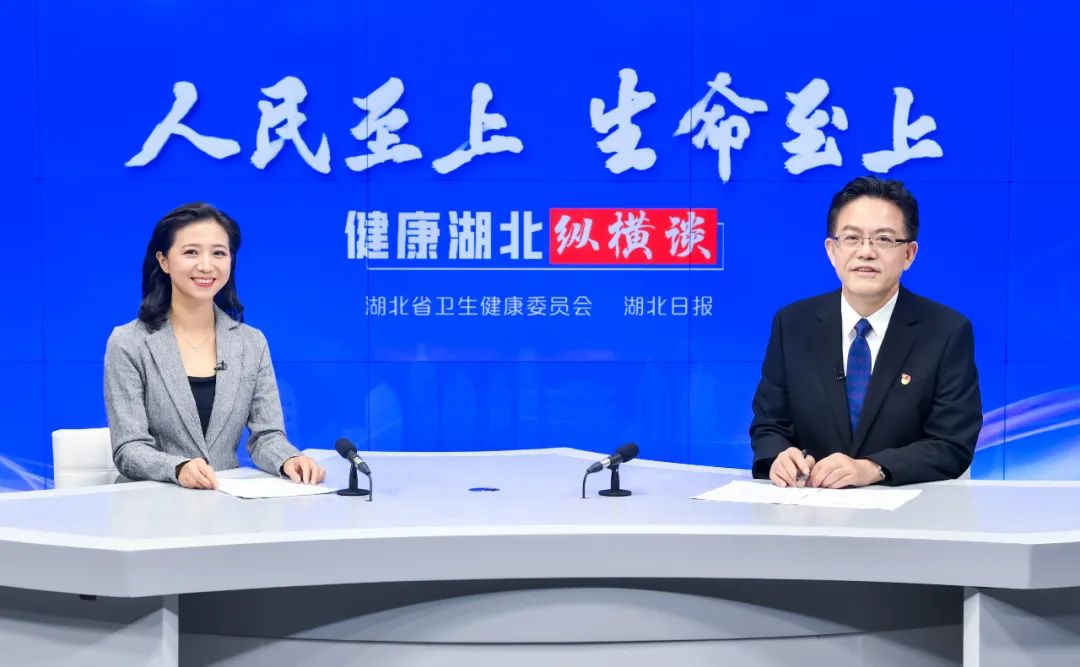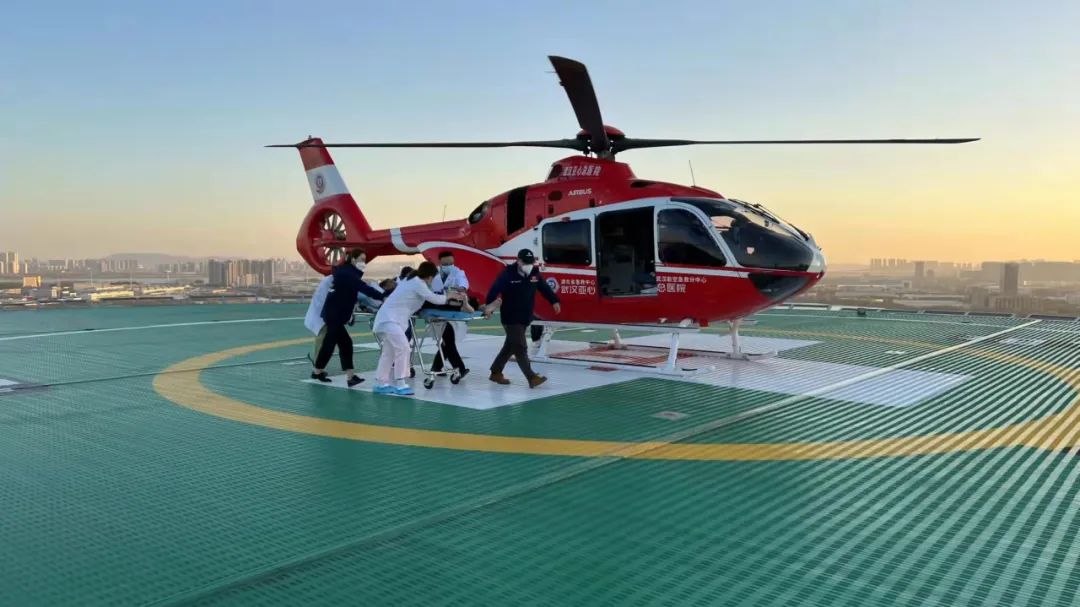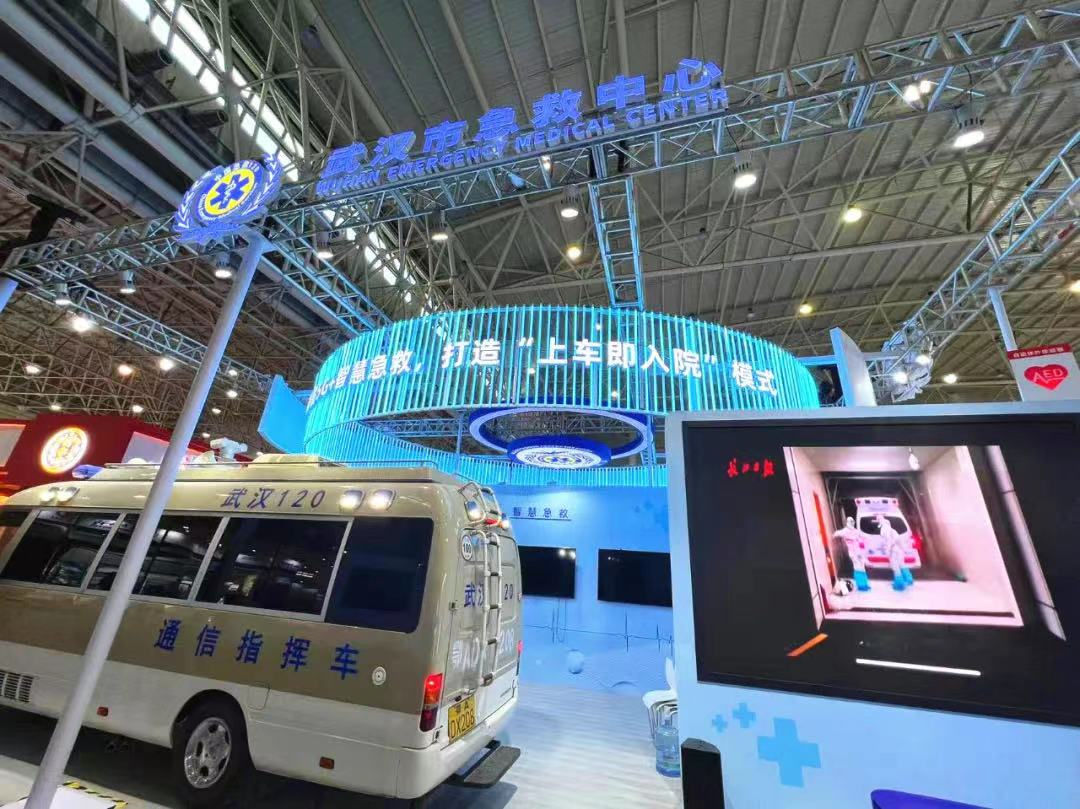Average 10 minutes and 17 seconds to the scene!Behind the time of quiet years is their ferry for life
Author:Hubei Daily Time:2022.09.22

Every day, about 2507 calls for help ringtones sounded in the 120 dispatch hall of the Wuhan First Aid Center; every day, about 483 times of ambulance gallop in Wuhan Three Town; every day, more than 1,000 emergency rescue staff are running against the gods. … On September 20, Jiang Wangxiang, Secretary of the Party Committee and Director of Wuhan First Aid Center, was a guest of the Hubei Daily 5G studio, telling the story of "life ferry" of Wuhan emergency people.
Thinking of life
The phone is command, time is life. The first aid people are reluctant to be day and night, and the wind and rain, and the "medicine" is on the road, just to set up the bridge of life, and fully keep the people of the people.
—— Jiang Wangxiang

On September 20th, Jiang Wangxiang (right), secretary of the Party Committee and Director of Wuhan First Aid Center, was a guest talk about Hubei Daily Health Hubei. (Photo by Zhu Xiyong, a reporter from Hubei Daily All Media)
Classification
Make up for the emergency "empty window period"
In the eyes of first aid, time is life, and calls are commands.
Jiang Wangxiang introduced that in the past five years, the number of 120 telephone acceptance has reached 4 million times. Especially in the past two years, the number of telephone acceptance of Wuhan emergency center has increased at a rate of 10%. In 2021, the number of 120s received nearly 900,000 times. In the first half of this year, more than 400,000 calls were accepted by the central urban area, and the average daily accepted telephone number was 2507 times.
How to accurately identify and rescue the huge number of help calls, how to accurately identify and quickly rescue? "The moment the phone was connected, the first aid had begun." Jiang Wangxiang introduced that in 2013, Wuhan took the lead in applying MPDS (medical priority grading scheduling system) nationwide to guide the emergencyly by phone.
Before the arrival of emergency personnel, people around the patients were often helpless due to lack of professional first aid knowledge, so that the best rescue time was missing. After MPDS was put into use, the dispatcher "asked" to the alarm through the standardized process to quickly judge the condition, and it was divided into 6 levels according to the condition or the degree of injury. According to different levels, the dispatcher dispatch the ambulance according to a significant emergency response, and synchronizes the patient's information to the ambulance to make targeted first aid preparation in advance. After sending the car, the dispatcher will not hang up the phone, but instructs the for help or family members to rescue himself on the spot. Those who are in critical condition will keep the connection until the emergency personnel arrive at the scene, and make the emergency "node move forward" in front of the hospital.
"The system makes up for the" empty window period "before the ambulance arrives and won the golden time." Jiang Wangxiang remembered that a 3 -year -old girl had a coma due to a custard of custard and the parents called 120. Before the ambulance arrived, the scheduling staff guided parents to first aid. After 8 minutes of "keep the call", the girl coughed out foreign bodies and avoided a tragedy.

In the first half of this year, the center had passed more than 20,000 patients with MPDS "connecting".
"The telephone line is the lifeline, so we fully guarantee that the 120 phone is unimpeded." Jiang Wangxiang revealed that during the Wuhan epidemic, the emergency center called 15,000 calls a day during the peak. After the epidemic, in order to ensure the "people call me", the center opened 5 voice lines to ensure that 150 first -aid telephones came in and out. At the same time, the two disaster recovery backup bases of Wuchang and Hankou were established. If the data system of the emergency center fails, the system can be switched immediately to ensure the front -line scheduling on the spot.
New site
Build a "10 -minute first aid circle"
Wuhan has a population of tens of millions, the region is vast, and the rivers and lakes are vertical and horizontal. On average, the ambulance is sent every 2 minutes and 58 seconds. "Fast response must have dense first aid networks as support." Jiang Wangxiang introduced that after the epidemic, Wuhan City set up network emergency stations at a speed of 6 to 8 stations a year, and continuously woven secret emergency networks.
In the first half of this year, Wuhan newly built nine first -aid stations including Liyuan, Xinghuo, Taohua Island, Zongguan, Steel Capital, Honggang City, Zhongnan Second Road, Songgang, and Jiyuqiao. At present, Wuhan is building a "10 -minute first -aid circle in the central city", 81 first aid stations have been built, and the ambulance reaches an average of 10 minutes and 17 seconds, a year -on -year increase of 1 minute and 33 seconds.
Jiang Wangxiang admits that the emergency station in the central urban area is mostly concentrated in the rich areas of the old town and medical institutions, and the construction of emergency networks in the new development area and urban village reconstruction zone lags. This year, Wuhan will build 13 new first aid stations in Xincheng District. By 2025, the new city district will form a "12 -minute medical emergency circle". At the same time, the role of "one master leader" is based on the integration of martial arts and the integration of Hanxiao and Hanxiao as the breakthrough, and promotes the "1 + 8 Urban Circle" first aid cooperation.
"Enter the water"
Weaving "water, land, empty three -dimensional first aid network"
This year, a baby boy born for more than 10 days, due to complex congenital heart disease, hypertension of pulmonary artery, urgent condition, transferred to Wuhan for two hours of helicopter transshipment.
Jiang Wangxiang said that as of September this year, there were 154 cases of aviation medical rescue in Wuhan, and the route covered multiple provinces. Wuhan has become the largest number of flights in the eastern and central regions, with a referral success rate of 100%.
As early as 2018, Wuhan was listed as the first batch of pilot cities in the country's aviation medical rescue. At present, there have been two open space first aid stations in Wuhan City and 2 first -aid stations in the open space. Through cooperation with Wuhan First Hospital, Wuhan Central Hospital, Puren Hospital, etc., 8 standardized apron will be established. Aviation Medicine Appearance "1 hour emergency circle" will be gradually consolidated.
With the people's higher requirements for medical services, Wuhan's first aid landscape is also expanding, and the first aid tentacles are "entering the sky".

"Wuhan's waters are large, rivers and lakes are intricate, and drowning accidents occur." Jiang Wangxiang said that in order to make up for shortcomings with insufficient coordination and treatment capabilities of water aids and water police conditions, Wuhan Crosshay Center relies on Donghu Hospital to build Donghu Water Rescue Station; The first water emergency station in the Hubei section of the Yangtze River Basin in cooperation with the Yangtze River General Hospital, the Binjiang Water 120 emergency station. By the end of this year, Wuhan's central urban area will deploy three empty stations and 3 water emergency bases, and the emergency network will cover the water and land.
Mix seconds to dispute

Patients "enter the car and enter the hospital"
For the elderly, deaf and mute people, and other groups, they cannot ask for help themselves when they have a sudden disease. When you turn on your mobile phone, you can call the police with one click.
This is the "Smart First Aid" created by Wuhan First Aid Center. Through the "Internet+" first aid, it installed the "smart brain" for the emergency system.
Jiang Wangxiang introduced that the traditional first aid call for rescue mode is not suitable for some special groups. The emergency center launched the "interconnected first aid" APP in time, and the GPS positioning system was introduced into emergency rescue. Citizens only need to pay attention to the official micro -signal of "Wuhan First Aid" and enter the relevant information. Under emergency situations, one -click alarm can be accurately located. The geographical information, health information, and telephone calls of the call help rescue person reaches the emergency center system to maximize the time of gold treatment.
Surge in seconds, is the normal state of first aid. In order to shorten the treatment time of the front and the hospital, the center created a new diagnosis and treatment model of "patients getting on the car", and in 2016, they took the lead in launching an integrated construction of the front hospital in the hospital in 2016, and "moved forward" to the rescue department to the rescue department in 2016 to the rescue department. On the car.

Today, the 5G mobile base station network is installed on the 142 ambulances in Wuhan, and the information is connected with 60 medical institutions with 60 secondary levels. The surveillance of the patient's life signs on the ambulance can be transmitted to the hospital's emergency department in real time to achieve the interconnection of emergency centers, ambulances, and three -party first -aid information in the hospital, and continuously improve the success rate of treatment.
In the dense traffic, the ambulance car is difficult to travel, which was a problem that plagued Jiang Wangxiang. In 2019, the "first aid vehicle" broadcast was launched in Wuhan. When the vehicle driver uses Baidu map navigation, if an ambulance appears 1.5 kilometers around the vehicle, the navigation system will automatically emit voice, prompting the owner to give up.
"The response speed is faster, and I hope it will be more." Jiang Wangxiang said that in 2020, through cooperation with telecommunications and other departments, the 120 scheduling platform realizes the sharing of call rescue positioning information to guide the ambulance quickly. In addition, the ambulances of Wuhan Medical Institutions have installed GPS positioning systems to achieve information usually grasped and uniformly scheduling during wartime.
In Jiang Wangxiang's view, as a "life ferry", there is still a long way to go: "'14th Five -Year Plan' period, we will set up a sound system, efficient command, efficient command, efficient command, high efficiency, efficient command, efficient command, efficient command, efficient commands in front of the hospital. The front courtyard coordination, water and air -to -air complementary hospital front aid system, build a pre -hospital emergency team with compatible and sustainable development of large -scale cities, forming urban and rural coordination, flat warfare combination, open space collaboration, front courtyard integration in the courtyard The pre -hospital first -aid management and service model realizes everyone to enjoy high -quality first aid services. "
There have been 81 first aid stations in the central urban area of Wuhan. Before the end of the year, there are 3 air emergency stations and 3 water emergency bases.
The average response time of ambulances is 1 minute and 9 seconds
Average ambulance reaches 10 minutes and 17 seconds
As of September this year, Wuhan Aviation Medical Rescue had 154 cases, and the success rate of vacant referral was 100%.
Source: Hubei Daily All Media Reporter Yu Jinyi Correspondent Luo Shuangping
- END -
The audience of the Changchun Air Show grabbed the throne three hours in advance, and the J-20 was surrounded

Jimu Journalist Zhan Yan Liu XiaobinOn August 26, the Air Force Airlines Open Even...
Experience fresh beer flavor, come to Jinsan Beach for drinking!
Toast! With the crispy touch of the cup, the Qingxi Gold Brewery Crossing Experien...